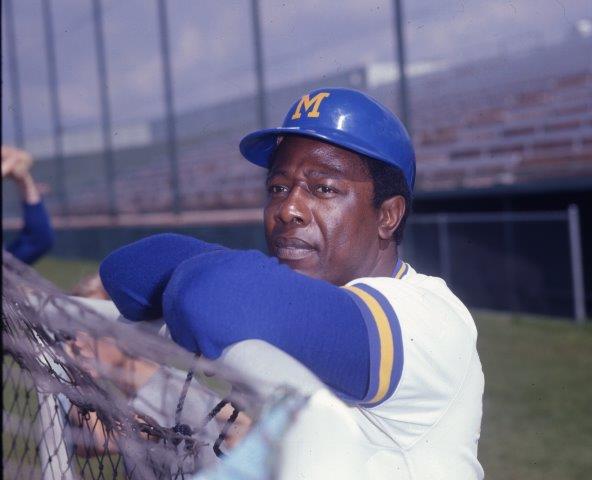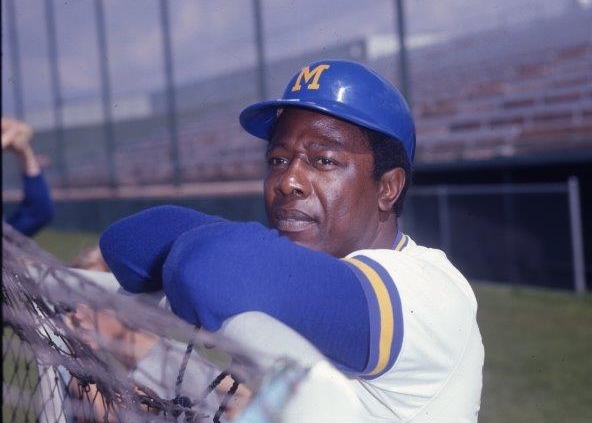April 11, 1975: Hank Aaron returns to Milwaukee, as a Brewer
 “It’s a thrill not only playing baseball in Milwaukee, but being back in a city which has been like home to me,” gushed Henry Aaron about his return to County Stadium for the first time in 10 years.1 “I’m looking forward to it,” said the 41-year-old Aaron about confronting the challenges of playing a new position for a new team in a different league. After 21 big-league seasons, baseball’s home-run king had nothing left to prove, adding, “The pressure is off. I haven’t been this relaxed in a long time.”2
“It’s a thrill not only playing baseball in Milwaukee, but being back in a city which has been like home to me,” gushed Henry Aaron about his return to County Stadium for the first time in 10 years.1 “I’m looking forward to it,” said the 41-year-old Aaron about confronting the challenges of playing a new position for a new team in a different league. After 21 big-league seasons, baseball’s home-run king had nothing left to prove, adding, “The pressure is off. I haven’t been this relaxed in a long time.”2
No player personified baseball in Milwaukee like Hammerin’ Hank. As a 23-year-old he led the Braves to the World Series title in 1957 and to the pennant the following season. After 13 winning seasons in Milwaukee (1953-1965), the Braves departed for the more lucrative and fast-growing market of Atlanta, leaving the Cream City pining for baseball and its prodigal son. Major-league baseball returned to Milwaukee in 1970 with the relocation of the Seattle Pilots, but the renamed Brewers had slogged through five straight losing seasons and had failed to capture fans’ interest as the Braves had. Brewers owner Bud Selig envisioned Aaron as an opportunity to reinvigorate a fan base and connect the Milwaukee baseball traditions of the Braves and Brewers.
By the end of the 1974 season, it was clear that Aaron was no longer in the Braves’ future. He whacked his 715th career home run, on April 8, to break Babe Ruth’s record, but played in a career-low 112 games and hit just 20 home runs, the fewest since his rookie season in 1954. Suffering from achy knees, Aaron could no longer play regularly in the field; however, the designated hitter, introduced just two years earlier in the AL, gave him a chance to continue his career.
The Brewers were not just a perfect fit for Aaron, they were the only fit. “When the thing first started about me coming to the American League, I didn’t want any other clubs bidding for my services,” Aaron explained. “I made up my mind Milwaukee would be the place I’d play. I would have quit baseball if I hadn’t come back to Milwaukee.”3 Aaron had played with the Brewers’ manager, Del Crandall, in Milwaukee for 10 seasons and knew Selig well from the time when he was a minority owner of the Braves before their relocation to Atlanta.
Aaron’s return to Milwaukee and County Stadium was an extravaganza. In the week leading up to the Brewers’ home opener on Friday, April 11, businesses displayed “Welcome Home, Henry” signs. On a sunny yet cold 37-degree day, fans began arriving at the ballpark by 9 A.M. to line up at ticket booths and started tailgating, grilling bratwursts, and drinking beer. By noon, traffic in the area was at a standstill.
County Stadium was rocking with 48,160 fans, a Brewers record and the second-largest crowd in the ballpark’s history, trailing only the 48,642 on September 27, 1959, when the Braves took on the Philadelphia Phillies.4 The festivities began with a red-carpet pregame introduction of Aaron. It commenced with band leader Steve Swedish and his 16-piece orchestra revving up the boisterous crowd. Then tenor Joe Feeny, known for appearances on the Lawrence Welk Show, led the excited mass in the singing of “Welcome Home, Henry,” set to the tune of “Hello, Dolly.”5 “I loved it,” said an exuberant Aaron of the sentimental yet warm-hearted kitsch.6 Flanked by several dignitaries, including Commissioner Bowie Kuhn and AL President Lee MacPhail, both of whom were roundly booed, Aaron briefly addressed the crowd. Met with a thunderous ovation, Aaron expressed his gratitude to the overflowing throng, saying, “I have a special place in my heart for Milwaukee’s wonderful fans,” and sending the multitude into an even louder round of applause and hollering.7
Even the players seemed dressed festively, opined sportswriter Ralph Trower, pointing to the Indians’ bright red uniforms, the Brewers’ more subtle home whites, accented with gold and blue banding, and the umpires’ blue slacks and maroon sports jackets.8 After a 10-minute delay, the game got underway at 1:40 when 27-year-old right-hander Bill Champion tossed the first pitch. Coming off a breakout season, in which he went 11-4 to improve his career slate to 28-43, Champion set down the side in order, including Frank Robinson batting in the two-hole. The capacity crowd gave Robinson, who had become the majors’ first African-American skipper just days earlier, a rousing ovation. Conspicuously absent from the playing field was Aaron, who was still acclimating himself to his batting-only role as DH. “It was a strange feeling not to take the field each inning to go on defense,” admitted Aaron. “I ran up and down the steps, back and forth, to the clubhouse to keep warm.”9
All eyes were trained on Aaron, batting third, when he came to the plate with two outs in the first. On the mound was 39-year-old graybeard Jim Perry, a former AL Cy Young Award recipient with the Minnesota Twins in 1970. The 211-game winner and junkballer faced Aaron for the first time and played it safe. After fouling off three straight pitches, Aaron drew a walk on a full count.10 He was still getting accustomed to how AL umpires interpreted the strike zone. “In spring training, they didn’t call the high strike,” he said.11 Entering the game hitless in six at-bats with two walks in the first two games with the Brewers, Aaron was still discriminating at the plate and had more career walks than strikeouts. “I’ve been a guess hitter all my life,” he mused, “and if I get what I’m looking for, I’m going to hit it.”12
In a scoreless game, Bob Coluccio led off the bottom of the third with a walk and moved to third on mutton-chop-clad Johnny Briggs’s single. In his second at-bat, Aaron hit a sharp grounder to short to force Briggs, but drove in the game’s first run and his first in a Brewers uniform as the ballpark erupted again in jubilation. In his prime Aaron was a threat on the basepaths, swiping a career-high 31 bags in 1963 when he became just the third player to join the exclusive 30-home-run, 30-stolen-base club, but had attempted only three stolen bases in the previous two seasons. In an unexpected move, he was nabbed easily trying to steal second in what proved to be his only attempt of the entire season. Nonetheless, Henry could do no wrong on this day and the crowd cheered him.
The Tribe answered in the fourth. With two on and two outs, Buddy Bell singled to drive in Charlie Spikes and tie the score, 1-1.
Briggs broke the tie by leading off the sixth with a home run into the gap in the right-field bleachers. “It would have been out no matter where I hit it,” he quipped.13 Aaron sent the crowd into another frenzy when he rocketed Perry’s first pitch into left field, but it curved for a foul.14 Three pitches later, he smashed a hard grounder. Third baseman Bell made a diving attempt to catch it, but it glanced off his glove and into left field for Aaron’s first hit as a Brewer. “My base hit was on a slow slider,” he said after the game.15 Three batters later, Perry followed his skipper’s orders and intentionally walked Darrell Porter to face Sixto Lezcano with two outs. The plan backfired when the rookie from Puerto Rico lined to right, driving in Aaron to give the Brewers a 3-1 lead and send Perry to the showers.
Reliever Dick Bosman, a one-team AL ERA champ, should have had an easy third out when Lezcano was caught in a rundown attempting to steal second. According to Brewers beat writer Lou Chapman, second baseman Jack Brohamer suddenly whipped the ball to third to nab Porter, who had taken a few steps off the bag; however, his throw was offline, allowing Porter to get back to third and Lezcano to first.16 Lezcano subsequently stole second and the floodgates opened. Pedro Garcia doubled to drive in both runners and make it 5-1. The Indians shot themselves in the foot again when shortstop Ed Crosby’s throw on Robin Yount’s routine grounder drew Boog Powell off the bag, allowing Garcia to score from second.
Champion was cruising, working on a five-hitter when he took the mound in the ninth with a 6-1 lead. “Billy can’t pitch much better than he did today,” said Crandall, who could write a book about good pitching after catching the Braves’ “Big Three” of Warren Spahn, Lew Burdette, and Bob Buhl during that team’s glory days.17 Champion stumbled, yielding singles to John Ellis and Brohamer and a two-out run-scoring double by Crosby. While Crandall was roundly booed for replacing Champion with Tom Murphy, two youths ran onto the field and were apprehended by police, reported the Milwaukee Journal, which noted that three others had jumped on the field earlier in the game.18 Murphy retired Oscar Gamble to end the game in 2 hours and 10 minutes to secure the Brewers 6-2 victory in Aaron’s return to Milwaukee and County Stadium.
Acknowledgments
Thanks for Ken Keltner (Milwaukee) SABR chapter member Dennis Pajot for obtaining copies of the Milwaukee Journal and Milwaukee Sentinel during the COVID-19 pandemic.
Sources
In addition to the sources cited in the Notes, the author accessed Retrosheet.org, Baseball-Reference.com, Newspapers.com, and SABR.org.
Notes
1 Lou Chapman, “At 41, Aaron Tackling New Job as Brewers DH,” The Sporting News, April 19, 1975: 3.
2 Chapman, “At 41, Aaron Tackling New Job as Brewers DH.”
3 Chapman, “At 41, Aaron Tackling New Job as Brewers DH.”
4 Mike O’Brien (Associated Press), “Welcome Home Henry Day Successful as Brewers Belt Tribe,” Sheboygan (Wisconsin) Press, April 12, 1975: 14.
5 Lew Cornelius, “Thanks to Grandmothers, 48,160 See the Opener,” Capital Times (Madison, Wisconsin), April 12, 1975: 16.
6 Cornelius.
7 Cornelius.
8 Ralph Trower, “Sports Spectrum,” Journal Times (Racine, Wisconsin), April 12, 1975: 8.
9 Trower.
10 Trower.
11 Chapman, “At 41, Aaron Tackling New Job as Brewers DH.”
12 Chapman, “At 41, Aaron Tackling New Job as Brewers DH.”
13 Mike Gonring, “Champion Is Just That for Brewers,” Milwaukee Journal, April 12, 1975: 10.
14 Lou Chapman, “It’s a Happy Return for Aaron,” Milwaukee Sentinel, April 12, 1975: 15.
15 O’Brien.
16 Chapman, “It’s a Happy Return for Aaron.”
17 Gonring.
18 Robert W. Wells, “Looking Swell, Henry,” Milwaukee Journal, April 12, 1975: 1.
Additional Stats
Milwaukee Brewers 6
Cleveland Indians 2
County Stadium
Milwaukee, WI
Box Score + PBP:
Corrections? Additions?
If you can help us improve this game story, contact us.


